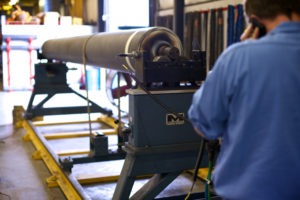 Do you know to what standard your motor shop is balancing your rotating equipment? Is your shop’s equipment even capable of precision balancing and reporting? A couple of thousandths can make a difference in the longevity of a machine. So here are some questions you should ask about how your motor shop balances your rotating equipment.
Do you know to what standard your motor shop is balancing your rotating equipment? Is your shop’s equipment even capable of precision balancing and reporting? A couple of thousandths can make a difference in the longevity of a machine. So here are some questions you should ask about how your motor shop balances your rotating equipment.
Why Balancing is Important
Before diving into the questions, let’s take a moment to establish why balancing is vital to your rotating machinery. First, properly balanced equipment will last longer, implying that failure is less likely, and that the ROI will be better than equipment that isn’t regularly balanced. When rotating machinery is properly balanced, bearing loads will be reduced, and the bearings will last longer. In addition, proper balancing leads to equipment that runs more efficiently, increasing productivity and reducing M&O costs. Balanced equipment also increases safety and reduces issues with noise and vibration.
Quick Overview: ISO 1940-1:2003
One of the most widely used standards for balancing is ISO 1940, which deals with balance quality requirements for rigid rotors. Understanding this standard is an excellent start to understanding how precision is measured. ISO 1940-1:2003 focuses on the quality requirements associated with balancing. In addition, this standard is the basis for other standards, such as ANSI S2.19-1975, British standard BS 6861: Part 1, and the German VDI 2060 standard.
A significant part of this standard is the Balance Quality Grade.
The Balance Quality Grade is based on the rotor type and ranges from G 4000 to G 0.4, where the numbers represent the vibration velocity in mm/s. The grade is based on the rotor type because geometrically similar rotors running the same speed generate similar stresses in the bearings and rotors.
The G 4000 grade is used for crankshafts and drives of rigidly mounted, slow marine diesel engines with an uneven number of cylinders. Applications for those types of engines can handle a significant amount of imbalance before performance is affected. And larger G grades result in higher stress.
The next grade up is G 1600, which applies to large, two-cycle rigidly mounted engines. G 0.4 is the highest grade and is used for applications that can handle the least amount of imbalance. For example, gyroscopes, disk drives, and spindles on high-precision milling equipment require a G 0.4 Balance Quality Grade.
So, what difference does the G value make? G is the product of the eccentricity (in mm) times the operating frequency (in Hertz). The permissible imbalance Uper is directly related to the G number, the rotor weight, and the maximum service speed of rotation. The smaller the acceptable imbalance, the more precise the balancing.
What is Your Shop’s Standard for Precision Balancing?
This is the first question you should ask. A quality repair shop will be complying with ISO 1940-1 or implement their own shop standards that achieve even higher precision.
What Balancing Grade Are You Using?
If they are following ISO 1940-1 or better, find out what the Balance Quality Grade (G number) they are using. Most electric motor applications fall within the following grades:
- G 16 — applicable to rigidly mounted crankshafts and drives, propeller shafts, drive shafts, and parts of cursing and agricultural machinery
- G 6.3 — applicable to medium and large electric armatures (at least 80 mm shaft height and a maximum speed of 950 rpm), small electric armatures, flywheels, fans, pump impellers, general machinery parts, and machine tools
- G 2.5 — medium and large electric motor and generator armatures, computer memory drives and discs, gas and steam turbines, compressors
- G 1 — audio, video, and tape recorders, phonograph drives
- G 0.4 — which we’ve already discussed
Shops can use higher levels of precision that what is recommended by ISO 1940-1. For example, for a large electric armature with a shaft height of 100 mm and a max speed of 750 rpm, a G value of 6.3 would comply with the standard, but a shop may aim for a G value of 6 to achieve even more precision.
How Precise is Your Balancing Equipment?
Something else to remember is the level of precision a shop’s balancing equipment can achieve. If their equipment can only achieve precision equivalent to G = 6.3, they can’t promise you any better precision than that. And grades 2.5 and below can only be achieved on highly specialized equipment.
Why a Lack of Precision Matters?
Earlier, we mentioned that the greater the imbalance, the greater the stress on the shaft, bearings, and supporting structure. Shafts experience fatigue stresses that can lead to catastrophic failure. Bearings carrying loads from directions they weren’t intended to or support loads in excess of what they were designed to withstand can be catastrophic. Vibration levels increase, and resonance may occur. Fasteners begin to work loose, components fail, and everything comes to a grinding halt (literally and figuratively). Imprecise balancing solves nothing and may make things even worse.
Conclusion
At Hi-Speed Industrial Service, we comply with and go beyond the strict balancing standards of ISO 1940-1. Our experienced technicians provide advanced field and shop balancing with complete documentation to ensure that your rotating equipment has a long, productive, reliable service life. Contact us today to learn more about how we can precision balance your equipment!

